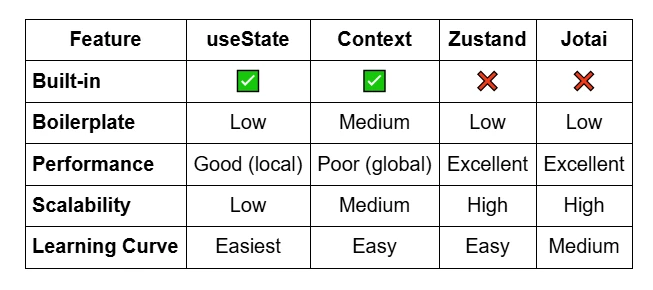A major and highly talked about and argued-over subject within the React ecosystem is state management. How you manage state could affect the scale, maintenance, and effectiveness of your project, regardless of whether you're creating simple apps for tasks or a huge business dashboard. Developers have had plenty of options in recent times, including using the state for its ease of access, React Context for easing digging for props, and even independent libraries such as Zustand and Jotai for light but robust solutions.
We'll talk about the big state management issue in this blog and help you choose the best method for your project.
Why State Management Matters
State is essentially the “memory” of your app—the data that determines what’s being shown to users and how it behaves when they interact with it. As applications grow, state management gets complicated:
- How do you share state between deeply nested components?
- How do you keep state updates predictable and fast?
- How do you prevent re-renders from killing performance?
Choosing the right state management strategy saves hours of debugging and future headaches.
Option 1: useState - The Basics
React's built-in usage The state hook is the easiest method to keep track of state.
When to Use:
- State of the local component (like form inputs, toggles, and modals).
- Apps with minimal shared state.
Pros:
- Dead simple and built into React.
- Perfect for quick prototypes and small apps.
Cons:
- Doesn’t scale well for global or deeply shared state.
- Passing state down multiple levels becomes painful (“prop drilling”).
Verdict: useState is your go-to for local, isolated state. But once your app grows, you’ll want more robust solutions.
Option 2: React Context - Sharing State Across Components
React Context is a method to move state through the tree of components without drilling props.
When to Use:
- Light global state, like theme (light/dark mode), authentication, or language settings.
- When avoiding prop drilling is the main concern.
Pros:
- Built into React—no external library required.
- Great for small to medium apps with limited shared state.
Cons:
- Overuse can lead to “Context Hell.”
- Every consumer re-renders on provider value changes, which can impact performance.
Verdict: Use context for small amounts of global state, but avoid treating it as a full state management solution.
Option 3: Zustand - Lightweight Yet Powerful
Zustand is a small but mighty state management library. It combines simplicity with performance, thanks to its minimal API and selective rendering.
When to Use:
- Medium to large apps with complex shared state.
- Apps needing scalable, performant state management without boilerplate.
Pros:
- Tiny footprint and no boilerplate.
- Only re-renders components that use the updated slice of state.
- Easy to integrate and reason about.
Cons:
- Requires an additional dependency.
- Not as well-known as Redux (though gaining massive traction).
Verdict: Zustand hits the sweet spot between simplicity and power. It’s an excellent choice for production apps where performance matters.
Option 4: Jotai - The Atomic Approach
Jotai takes an “atomic” approach to state management. Each piece of state is an atom, and components subscribe directly to the atoms they use.
When to Use:
- Apps with complex, interdependent states.
- Projects where fine-grained reactivity is needed.
Pros:
- Minimal API with maximum flexibility.
- Components only re-render when the specific atom they rely on changes.
- Scales elegantly with application complexity.
Cons:
- Newer library, so ecosystem is still growing.
- Slightly steeper learning curve than Zustand.
Verdict: Jotai is a forward-looking approach to state management. If you like the idea of granular control and modern patterns, it’s a great pick.
Head-to-Head Comparison

Which One Should You Choose?
- Start simple: Use useState for local state.
- For light global needs, React Context is enough.
- For scalable apps, Zustand is often the best middle ground.
- Jotai is worth looking at if you want fine-grained control and contemporary flexibility.
In real life, a lot of applications utilize these technologies together: useState for local UI state, Context for themes and authentication, and Zustand or Jotai for sophisticated shared state.
Conclusion
The question of state management has never been the answer to a single perfect solution; rather, it is the answer to the proper tool at the proper place. Being familiar with the pros and cons of useState, Context, Zustand, and Jotai, you can create React applications of any scale that work efficiently.
Do not over-engineer state management at the outset. Start small, and grow as you require. Partner with an experienced ReactJS development company today!


